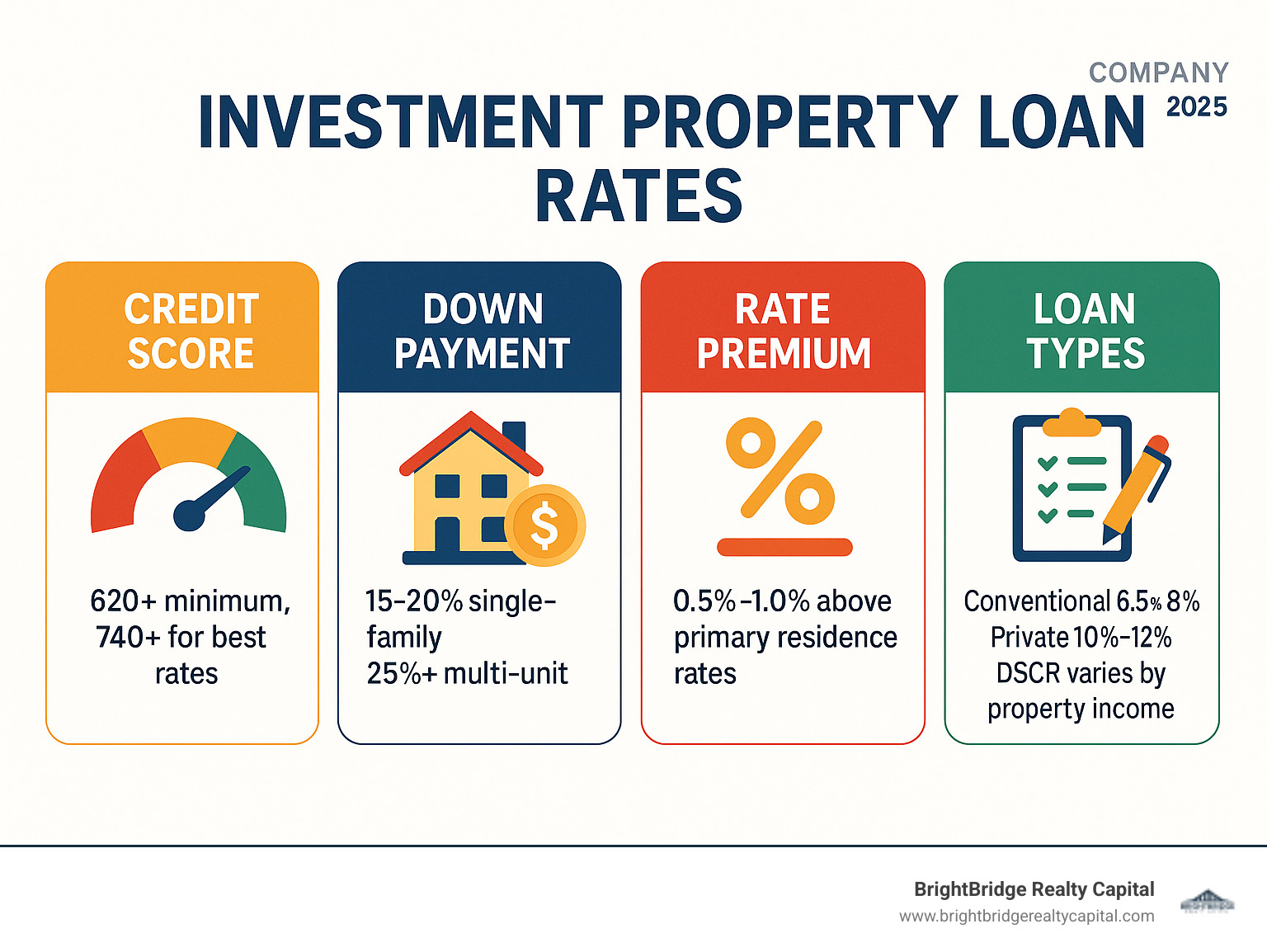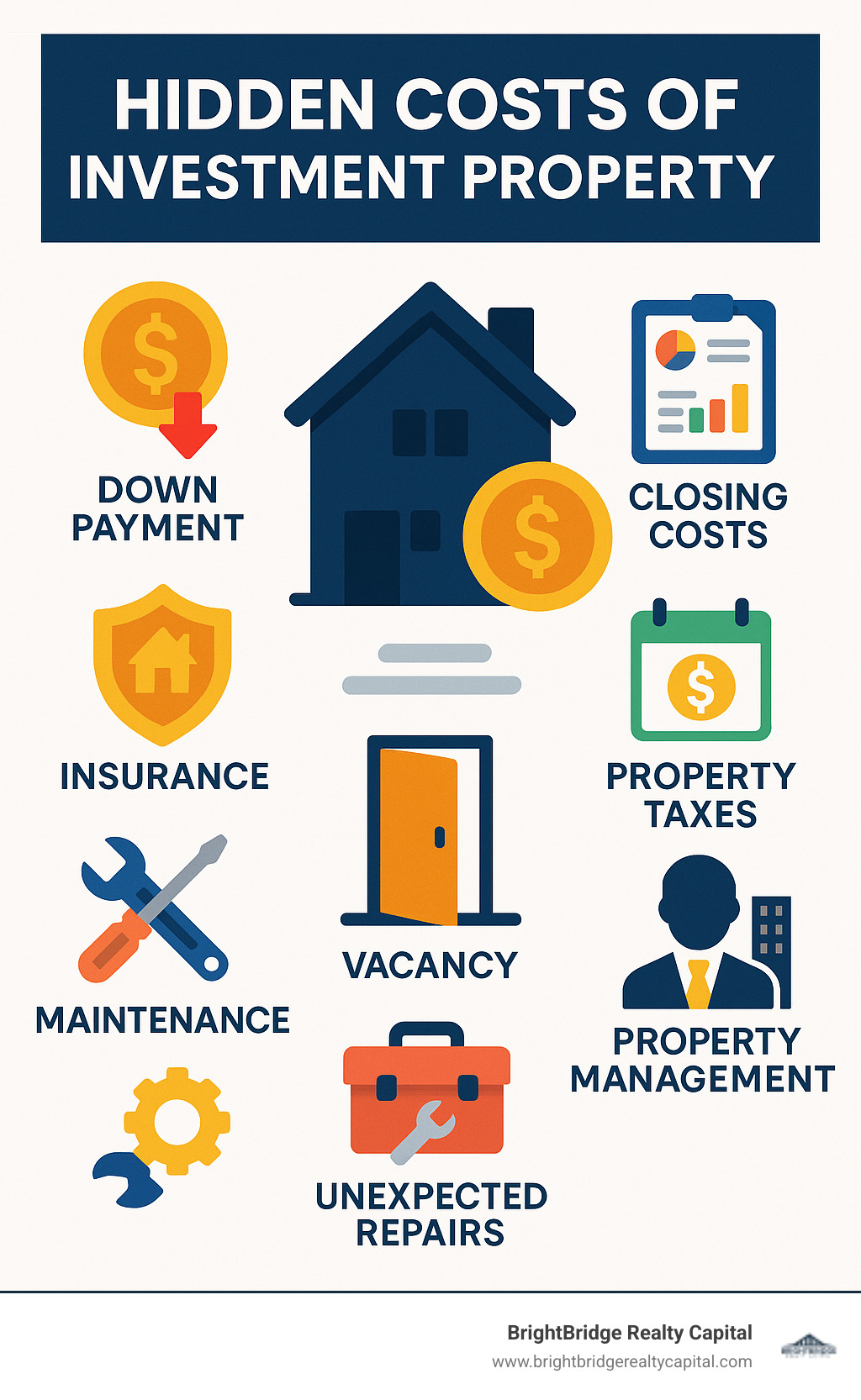A Quick Start Guide to Finding Investment Property Loan Rates

Why Investment Property Loan Rates Matter for Your Success
Understanding investment property loan rates is the first step toward building a successful real estate portfolio. These rates are the fundamental cost of leverage, the tool that allows you to control a valuable asset with only a fraction of its total price. While it's true that rates for investment properties are typically 0.5% to 1.0% higher than for a primary residence, this premium is simply the price of admission to the world of real estate wealth creation. In today's market, you can generally expect rates to fall between 6.5% and 8% for traditional conventional loans, while more specialized financing, like private or hard money loans, can range from 10% to 12% or even higher, depending on the deal's specifics.
The seemingly small percentages can have a monumental impact on your long-term profitability. Consider a $400,000 investment property. An interest rate increase from 7.0% to 7.75% might seem minor, but it translates to an additional $164 in your monthly mortgage payment. Over the 30-year life of the loan, that seemingly small 0.75% difference amounts to over $59,000 in extra interest payments. That's $59,000 that could have been reinvested, used for property upgrades, or simply added to your net worth. This illustrates why savvy investors don't just accept the first rate they're offered; they strategically position themselves to secure the most favorable terms possible.
Lenders apply this rate premium because, from their perspective, investment properties carry a higher degree of risk. Statistical data shows that when a borrower faces financial hardship, they are far more likely to default on a rental property mortgage than the mortgage on their own home. This elevated risk of default is priced into the loan through higher rates and stricter qualification standards. To a lender, you are not just a borrower; you are a business partner in a real estate venture, and they need to be compensated for the risk they are taking on.
To navigate this landscape successfully, you must understand the key factors that lenders scrutinize:
- Credit Score: This is your financial reputation. A score of 740 or higher is the gold standard and unlocks the best rates. While some lenders may approve loans for scores as low as 620, the rate and fees will be significantly higher.
- Down Payment: This represents your "skin in the game." A larger down payment lowers the lender's risk. Expect to need 15-20% for a single-family rental and 25% or more for multi-unit properties (2-4 units).
- Property Type: Lenders view single-family homes as the least risky type of residential investment, often rewarding them with slightly better rates than duplexes or fourplexes.
- Loan Type: The financing vehicle you choose has its own rate structure. A conventional loan from a bank will be priced differently than a DSCR loan focused on property cash flow or a short-term hard money loan for a quick renovation project.
I'm Daniel Lopez, a loan officer at BrightBridge Realty Capital. My expertise lies in helping real estate investors, from first-timers to seasoned professionals, navigate the complexities of investment property loan rates. I specialize in structuring financing for both residential and commercial deals, ensuring my clients secure the most advantageous terms by aligning their financial profiles with lender expectations and underwriting guidelines.

Understanding Investment Property Loan Rates
Investment property loan rates are the price you pay for the opportunity to generate wealth through real estate. Lenders perceive these loans as carrying a greater risk compared to a mortgage for your primary home, and this perception of risk is directly monetized into higher borrowing costs for you, the investor. This isn't an arbitrary decision; it's a calculated business practice rooted in historical data and risk management principles.
The core reason for this discrepancy is the default likelihood. Lenders operate on the logical assumption that if a borrower encounters severe financial distress, the payment they will fight hardest to make is for the roof over their own family's head. The investment property mortgage becomes a secondary priority. This elevates the statistical probability of default, making the loan a riskier asset on the lender's books. Compounding this is vacancy risk—the ever-present possibility that a tenant leaves, immediately halting the property's income stream. A few months of vacancy can quickly turn a profitable investment into a liability, further increasing the lender's exposure.
To systematically price this risk, lenders, particularly those who sell their loans to government-sponsored enterprises (GSEs) like Fannie Mae and Freddie Mac, use a framework called Loan-Level Price Adjustments (LLPAs). These are not arbitrary fees but specific, pre-determined adjustments to your interest rate based on a matrix of risk factors. For a single-family investment property, this LLPA might add 0.5% to 0.75% to your base rate. For multi-family properties (2-4 units), which are seen as more complex to manage, the adjustment can be even higher, often ranging from 0.625% to 1.0%.
What Are Investment Property Loans?
An investment property loan is any financing obtained for a residential property that you do not intend to occupy as your primary residence. The critical legal and financial term is non-owner-occupied. This classification triggers the higher rates and stricter underwriting guidelines.
These loans are the financial backbone for a wide array of investment strategies, including:
- Long-Term Rentals: The classic model of buying a single-family home, duplex, or condo and renting it to tenants on an annual lease.
- Short-Term / Vacation Rentals: Properties rented out on a nightly or weekly basis through platforms like Airbnb and Vrbo. These can offer higher income potential but also come with more intensive management and income volatility, which lenders analyze closely.
- Multi-Unit Buildings: This category includes duplexes, triplexes, and fourplexes. It's important to note that even if you plan to live in one unit (a strategy known as "house hacking"), many lenders will still classify the loan as an investment property loan, especially if using conventional financing, though some government programs offer exceptions.
The unifying principle is that the property is being acquired as a business asset with the primary goal of generating income, either through monthly cash flow from rent, long-term appreciation in value, or a combination of both.
Why Rates Differ from Primary Residences
The entire rate differential can be distilled down to a single, powerful word: risk. A lender's primary business is to lend money and be paid back with interest. Any factor that jeopardizes repayment increases risk, and increased risk must be compensated with a higher return.
This risk assessment manifests in two key ways for investors:
- Higher Interest Rates: As established, you can expect your rate to be 0.50% to 1.0% higher than the going rate for a primary home. If a top-tier borrower can get a 6.0% rate on their personal home, they should expect to be quoted between 6.5% and 7.0% for an identical property purchased as an investment.
- Stricter Qualification Criteria: Lenders build a fortress of requirements around investment loans. They demand higher credit scores (often a 720-740 minimum for the best terms), larger down payments (20-25% is standard), and significant cash reserves. Lenders will want to see that you have enough liquid cash to cover 6 to 12 months of principal, interest, taxes, and insurance (PITI) for the new property, in addition to reserves for any other properties you own. This ensures that you can weather a period of vacancy or an unexpected major repair without defaulting on the loan.
Key Factors That Influence Your Rate

Securing a favorable investment property loan rate is not a game of chance; it's a direct result of a lender's comprehensive risk assessment. They are meticulously assembling a puzzle of your financial life to answer two fundamental questions: your proven ability to repay the loan and the inherent risk of the asset you're purchasing. Mastering these factors puts you in control of the lending process.
Your Personal Financial Profile
Your personal financial strength is the bedrock of your loan application. Lenders need irrefutable proof that you are a reliable and low-risk borrower, capable of managing another mortgage payment even if the property's income stream is temporarily disrupted.
Credit Score: This three-digit number is the most critical summary of your financial history. Lenders use the FICO score model, and while some non-conventional lenders might accept scores in the 620s, the most competitive investment property loan rates are reserved for borrowers with scores of 740, 760, or even 780 and above. Each 20-point tier in your credit score can correspond to a tangible change in your interest rate or closing costs. It's essential to check your credit report months in advance from the official, free source, AnnualCreditReport.com, to dispute any errors and address any weaknesses.
Debt-to-Income (DTI) Ratio: This metric reveals how much of your gross monthly income is already committed to debt payments. It's calculated by dividing your total monthly debt obligations (mortgage, car loans, student loans, credit card payments) by your gross monthly income. For investment properties, most conventional lenders impose a strict DTI limit, often 43% or 45%. A lower DTI demonstrates that you have significant financial breathing room and can easily absorb the new mortgage payment.
Cash Reserves: This is your financial safety net, and lenders take it very seriously. They want to see liquid or near-liquid assets sufficient to cover a set number of months of PITI (Principal, Interest, Taxes, and Insurance) for all your financed properties, including your primary residence and the new investment. The standard requirement is 6-12 months of reserves. These funds prove you can survive extended vacancies, tenant defaults, or major capital expenditures without jeopardizing your loan payments.
Loan-to-Value (LTV) Ratio: This ratio, calculated by dividing the loan amount by the property's appraised value, shows how much of your own capital is at risk. A lower LTV, achieved through a larger down payment, directly reduces the lender's risk. If you default, a lower LTV means the lender is more likely to recoup their full investment at a foreclosure sale. Consequently, lenders reward borrowers who put down 25% or 30% with better interest rates.
How Property Characteristics Affect Investment Property Loan Rates
The property itself is a co-applicant on your loan. Lenders analyze its characteristics to gauge its stability and income-producing potential.
Property Type: Single-family residences (SFRs) are the simplest and most liquid form of residential investment, generally securing the best rates. Multi-family properties (2-4 units) are excellent for scaling a portfolio but are considered more complex to manage, leading to slightly higher rates, often by 0.125% to 0.25%.
Location and Market Conditions: A property's location is paramount. Lenders prefer properties in stable or appreciating markets with strong economic fundamentals like job growth and population increases. They assess neighborhood classifications (e.g., Class A, B, C) and may be hesitant to lend in areas with declining property values or high vacancy rates. Furthermore, the broader macroeconomic environment, especially the Federal Reserve's monetary policy, sets the baseline for all interest rates, causing investment property loan rates to fluctuate with national trends.
How Rental Income Affects Your Application
For an investment property, its ability to generate income is a core component of the underwriting process. This is where the property must prove it can pay for itself.
Debt Service Coverage Ratio (DSCR): This is the most important metric for income-producing properties. The DSCR is calculated by dividing the property's Net Operating Income (NOI) by its total debt service (the annual mortgage payments). Most lenders require a DSCR of at least 1.25, which means the property's income is 25% greater than its mortgage payment. A strong DSCR gives the lender confidence that the property can sustain itself and even absorb minor vacancies or unexpected expenses. DSCR-focused loans are a popular product that qualifies the borrower based almost entirely on this ratio, ignoring personal DTI.
Calculating Rental Income: The method for verifying income depends on the property's status. For a property with tenants in place, lenders will require copies of the existing lease agreements to confirm the rental amount. For a vacant property, the lender will rely on the appraiser's professional assessment, known as the Form 1007 Single-Family Comparable Rent Schedule. This report analyzes comparable rental listings in the immediate area to establish a fair market rent, which is then used in the DSCR and DTI calculations.
Navigating Loan Types and Application Requirements

Choosing the right financing for an investment property is as critical as choosing the property itself. The loan product you select will shape your cash flow, your potential for scaling, and your overall return on investment. Each loan type is a specialized tool designed for a specific scenario. Understanding this toolkit is essential for making an informed decision that aligns with your long-term investment strategy. Furthermore, preparing a complete and organized application package from the outset can dramatically accelerate the lending process, saving you weeks of frustrating back-and-forth with underwriters.
Common Loan Products for Real Estate Investors
Conventional Loans: These are the workhorses of the investment loan world, offered by banks and mortgage lenders and adhering to the guidelines set by Fannie Mae and Freddie Mac. They offer competitive 30-year fixed rates but come with stringent requirements: high credit scores, low DTI ratios, and larger down payments (typically 20-25%). They are an excellent choice for investors with strong, easily documentable W-2 income and a smaller number of existing properties.
DSCR Loans: Debt Service Coverage Ratio (DSCR) loans have surged in popularity. These loans qualify the borrower based almost exclusively on the investment property's cash flow, not their personal income. If the property's rental income covers the mortgage payment (usually with a buffer, requiring a DSCR of 1.1 to 1.25+), your personal DTI is irrelevant. This makes them ideal for self-employed investors, those with complex finances, or investors looking to acquire more than the 10 properties allowed by conventional financing. You can explore these further on our rental property loans page. Be aware they often come with slightly higher rates and may have prepayment penalty clauses.
Portfolio Loans: These are loans that a lender (often a local community bank or credit union) originates and keeps on its own books rather than selling on the secondary market. This gives them significant flexibility to create custom loan terms. They might overlook a slightly lower credit score or be more creative with income documentation if you have a strong history and a good relationship with the bank. These are relationship-based loans and can be a powerful tool for investors planning to do repeat business in a specific market.
Bridge Loans: These are short-term financing solutions (typically 6-18 months) that "bridge" a gap in funding. For example, an investor might use a bridge loan to quickly purchase a new property before they have sold an existing one. They provide rapid access to capital, allowing investors to compete with cash buyers, but this speed comes at the cost of higher interest rates and fees.
Hard Money Loans: Often confused with bridge loans, hard money loans are asset-based loans provided by private individuals or funds. The primary underwriting criterion is the value of the property (the "hard asset"), not the borrower's creditworthiness. They can be funded in a matter of days, making them perfect for distressed properties, auction purchases, or deals that require a lightning-fast close. The trade-off is high interest rates (often 10-15%) and significant origination fees (2-5 points).
Fix-and-Flip Loans: This is a specialized, short-term loan product designed for investors who intend to renovate and quickly resell a property. These loans are unique because they are often based on the property's After-Repair Value (ARV), and can sometimes include the financing for the renovation budget itself, disbursed in draws as work is completed. Our fix-and-flip page provides more detail on how these are structured.
Down Payment and Documentation Checklist
Lenders require larger down payments on investment properties to ensure you have significant "skin in the game," making you less likely to walk away. For a single-unit property, the minimum down payment is typically 15%, but putting down 20% or 25% will secure better terms. For multi-unit properties (2-4 units), the standard minimum down payment is 25%.
Being prepared with the following documents will create a smooth and efficient underwriting experience:
- Tax Returns: At least two years of complete personal and business tax returns. If you already own rental properties, be sure to include all schedules, especially Schedule E, which details your rental income and expenses.
- Income Verification: Two of your most recent pay stubs, W-2s for the last two years, and/or 1099s. If you are self-employed, you will need a year-to-date profit and loss statement and a balance sheet.
- Asset Verification: Two to three months of statements for all asset accounts (checking, savings, brokerage, retirement) to verify your down payment funds and required cash reserves. Be prepared to source any large, non-payroll deposits.
- Property-Specific Documents: For a purchase, the fully executed purchase agreement. For a refinance, the existing mortgage statement and homeowners insurance declaration page. For occupied properties, copies of all current lease agreements.
- Business Entity Documents (if applicable): If you are purchasing in the name of an LLC or corporation, you will need the Articles of Organization, a signed Operating Agreement, and a Certificate of Good Standing.
How to Secure the Best Rates for Your Investment

Securing the lowest possible investment property loan rates is not a passive activity; it's an offensive strategy. By proactively managing your financial profile and approaching the lending market with a plan, you can directly influence the terms you are offered. Even a fractional improvement in your rate can translate into tens of thousands of dollars in savings over the life of the loan, significantly boosting your cash flow and overall return on investment.
Actionable Strategies for Lowering Your Investment Property Loan Rates
Optimize Your Credit Score: This is the single most impactful action you can take. The difference in rate offered to a borrower with a 680 credit score versus one with a 780 score can be 0.50% or more. Begin monitoring your credit at least six months before you plan to apply. Pay down credit card balances to below 30% of their limits (ideally below 10%). Never miss a payment, as a single 30-day late payment can drop your score by 50-100 points. Dispute any inaccuracies on your report. If you find an error, some lenders offer a "rapid rescore" service that can update your score in a few days once the error is corrected.
Aggressively Lower Your Debt-to-Income (DTI) Ratio: Your DTI ratio is a measure of your monthly leverage. To a lender, a low DTI means you have ample capacity to take on new debt. Before applying for a loan, analyze your existing debts. Can you pay off a small personal loan or a car loan with a low balance? Doing so can have a significant impact on your DTI calculation and may be the difference between an approval and a denial, or between a good rate and a great one. Aim to get your DTI below 43% for the best results with conventional lenders.
Maximize Your Down Payment: The more of your own capital you put into the deal, the less risk the lender assumes. This reduced risk is often rewarded with a lower interest rate. While you might be ableto secure a loan with 15% or 20% down, see if you can push to 25% or 30%. This not only improves your rate but also lowers your monthly payment and starts you off with a stronger equity position. Explore all options for sourcing your down payment, such as a HELOC on your primary residence, but be sure to have these funds seasoned (sitting in your account for at least 60 days) before applying.
Fortify Your Cash Reserves: Lenders need to see that you are financially resilient. Having 6 to 12 months of PITI (principal, interest, taxes, and insurance) payments saved in a liquid account for all your properties is a powerful signal of strength. It tells the lender that a three-month vacancy or a $5,000 HVAC replacement won't cause you to miss a mortgage payment. This reduces their perceived risk and can lead to better terms.
Shopping Around and Negotiating with Lenders
Loyalty rarely pays in the mortgage business. Never accept the first loan offer you receive without comparing it to others. Investment property loan rates and fees can vary significantly from one lender to another, as each has its own overhead, risk appetite, and pricing models.
Diversify Your Lender Outreach: Don't limit your search to one type of institution. Get quotes from a large national bank, a local credit union, and a specialized online lender or mortgage broker. Large banks may offer relationship discounts, credit unions often have lower fees, and mortgage brokers can access wholesale rates not available to the general public.
Become a Loan Estimate Expert: When you apply for a mortgage, the lender must provide you with a standardized three-page form called a Loan Estimate (LE). This document is designed for easy comparison. When you have LAs from multiple lenders, compare them line by line. Look beyond the interest rate. Pay close attention to Section A: Origination Charges. These are the fees the lender directly controls and are highly negotiable. Also, compare the APR (Annual Percentage Rate), which represents the total cost of borrowing, including fees.
Leverage Competing Offers: Once you have multiple Loan Estimates in hand, you have negotiating power. Go back to your preferred lender and show them the competing offer. You can say, "I'd really like to work with you, but Lender B is offering the same rate with $2,000 less in fees. Can you match that?" For strong, well-qualified borrowers, lenders often have some flexibility to adjust their pricing to win the business. Remember, the worst they can say is no, and you have nothing to lose by asking.
Beyond the Rate: Other Financial Considerations

While securing a competitive investment property loan rate is a critical victory, it's just one battle in the larger campaign of successful real estate investing. The most sophisticated investors understand that the interest rate is only one component of the total cost of ownership. A holistic financial analysis, accounting for all upfront and ongoing expenses, is necessary to accurately project profitability and build a resilient, long-term portfolio.
Hidden Costs of Financing an Investment Property
First-time investors are often surprised by the significant costs incurred before they ever collect their first rent check. These expenses go far beyond the down payment.
Closing Costs: These are the fees associated with originating and finalizing your loan. You should budget for 2% to 5% of the property's purchase price. On a $400,000 property, this can range from $8,000 to $20,000. These costs typically include:
- Lender Fees: Origination charges, underwriting fees, processing fees, and discount points (pre-paid interest to lower your rate).
- Third-Party Fees: Appraisal fee, credit report fee, flood certification, and survey fees.
- Title and Escrow Fees: Title search, lender's title insurance policy, and settlement agent fees.
- Prepaid Expenses: You'll often need to prepay for one year of homeowners insurance and several months of property taxes to fund your escrow account.
Title Insurance: While the lender's policy is required, it's highly advisable to purchase an owner's title insurance policy. This protects your equity from any future claims or disputes regarding the property's ownership history.
Higher Insurance Premiums: You cannot use a standard homeowners policy on a non-owner-occupied property. You will need a specific landlord insurance policy (often called a DP3 policy). This is typically 15-25% more expensive than a standard policy but provides crucial coverage for property damage, liability (in case a tenant is injured on the property), and loss of rental income if the property becomes uninhabitable due to a covered peril.
A Balanced View: Pros and Cons of Property Investing
Real estate offers a powerful path to financial independence, but it is not a passive or risk-free endeavor. A clear-eyed assessment of both the advantages and disadvantages is crucial.
| Pros of Property Investing | Cons of Property Investing |
|---|---|
| Consistent Cash Flow: Monthly rental income provides a steady, predictable revenue stream. | Illiquidity: Real estate cannot be converted to cash quickly or easily. |
| Long-Term Appreciation: Property values have historically trended upward, building significant equity over time. | Management Burdens: Dealing with tenants, toilets, and trash can be time-consuming and stressful. |
| Significant Tax Benefits: Deductions for mortgage interest, property taxes, operating expenses, and depreciation can shelter income. | Market Risk: Economic downturns or local market shifts can cause property values to decline. |
| Leverage: Using a loan allows you to control a large, valuable asset with a relatively small amount of your own capital. | Concentrated Risk: Unlike a stock portfolio, a single property represents a large, non-diversified investment. |
| Inflation Hedge: As the cost of living rises, so do rents and property values, protecting your purchasing power. | High Entry and Ongoing Costs: Requires a large down payment, closing costs, and reserves for taxes, insurance, and maintenance. |
| Tangible Asset: You own a physical asset that you can see, touch, and improve. | Vacancy Risk: An empty property generates no income but continues to accrue expenses. |
When to Consider Refinancing
Refinancing your investment property is a strategic financial maneuver that can dramatically improve your portfolio's performance. It's not just about chasing lower interest rates; it's about optimizing your capital.
Consider refinancing when:
- Rates Have Dropped Significantly: The general rule of thumb is to explore refinancing if you can lower your rate by at least 0.5% to 1.0%. On a $400,000 loan, a 0.75% rate reduction can save you over $160 per month and nearly $60,000 over the life of the loan.
- You Want to Access Equity (Cash-Out Refinance): As you pay down your mortgage and the property appreciates, you build equity. A cash-out refinance allows you to take out a new, larger loan and receive the difference in cash. This tax-free capital can then be used as a down payment for your next investment property, fueling the growth of your portfolio. This is the cornerstone of the popular BRRRR (Buy, Rehab, Rent, Refinance, Repeat) strategy.
- You Want to Change Your Loan Terms: Perhaps you have an adjustable-rate mortgage (ARM) and want the stability of a fixed rate. Or maybe you want to switch from a 30-year to a 15-year term to pay off the property faster and save on interest. Refinancing allows you to restructure your debt to better suit your current financial goals.
Always analyze the costs of refinancing (which are similar to original closing costs) against the potential savings or strategic benefits. A careful breakeven analysis will tell you if the move makes financial sense.
Frequently Asked Questions about Investment Property Loan Rates
As a loan officer specializing in real estate investment, I field hundreds of questions about the financing process. Many investors, both new and experienced, share the same concerns and uncertainties. Here are detailed answers to the most common questions regarding investment property loan rates.
What is a good interest rate for an investment property?
There is no single "good" rate; the term is entirely relative to the current market conditions and your specific financial profile. A more useful benchmark is to understand that a competitive investment property loan rate will almost always be 0.5% to 1.0% higher than the prevailing rates for primary residences. For example, if the best-advertised rate for a primary home mortgage is 6.0%, a well-qualified investor should expect to receive a rate in the 6.5% to 7.0% range for a conventional investment loan.
A "good" rate for you is the best rate you can qualify for based on your strengths. An investor with an 800 credit score, a 30% down payment, and 12 months of cash reserves will command a significantly better rate than an investor with a 680 credit score and a 20% down payment. The key is to optimize your financial profile and then shop with multiple lenders to ensure you are receiving the most competitive offer available for your specific situation.
Can I use a government-backed loan for an investment property?
Generally, no. Government-backed loan programs like FHA, VA, and USDA are designed to promote homeownership, not real estate investing. As such, they have a strict owner-occupancy requirement, meaning you must live in the property as your primary residence for at least the first 12 months.
The powerful exception to this rule is for owner-occupied multi-unit properties. This strategy, often called "house hacking," allows you to use a low-down-payment FHA loan (3.5% down) or a zero-down-payment VA loan to purchase a duplex, triplex, or fourplex. You must live in one of the units, but you can rent out the remaining units. The rental income from the other units can be used to help you qualify for the loan and can significantly reduce or even eliminate your personal housing expense. This is one of the most effective strategies for a first-time investor to enter the market.
How many investment property loans can I have?
This depends entirely on the type of lender. For conventional loans that are sold to Fannie Mae or Freddie Mac, there is a firm limit. Borrowers are typically restricted to financing a maximum of 10 residential properties, which includes your primary residence. The underwriting guidelines also become progressively stricter as you acquire more properties, especially after your fourth financed property.
However, this 10-property limit is not the end of the road. Investors looking to scale beyond this number must move into the world of portfolio lenders, private money, and DSCR loans. These lenders do not sell their loans to Fannie or Freddie and therefore set their own rules. Many portfolio banks and private lenders are happy to work with experienced investors who have large, complex portfolios, provided they have a strong track record and solid financials. At BrightBridge Realty Capital, we specialize in these types of scenarios and understand that serious investors cannot be constrained by conventional lending limits.
Should I pay "points" to lower my interest rate?
"Discount points" are a form of prepaid interest. One point is equal to 1% of the loan amount, and paying it upfront can permanently reduce your interest rate for the life of the loan. Whether this is a good idea depends on your investment timeline. You must calculate the breakeven point: divide the cost of the points by the monthly savings from the lower rate. The result is the number of months it will take to recoup your upfront cost. If you plan to hold the property long past the breakeven point, paying points can save you a significant amount of money. If you might sell or refinance before that point, it's better to take the higher rate and keep your cash at closing.
Can I buy an investment property in an LLC?
Yes, and it is often recommended for liability protection. Purchasing a property in a Limited Liability Company (LLC) separates the asset from your personal finances. However, be aware that most conventional lenders (Fannie/Freddie) will not lend to an LLC. You will typically need to use a commercial loan product, a portfolio loan, or a DSCR loan, which are designed to lend to business entities. These loans may have slightly higher rates and fees, but the legal protection is often worth the cost for serious investors.
Conclusion
You are now equipped with a comprehensive roadmap to successfully navigate the world of investment property loan rates. While the financing process can appear daunting, filled with jargon and complex calculations, remember that knowledge is your most valuable asset. By understanding the lender's perspective and the rules of the game, you transform from a passive rate-taker into a strategic borrower who actively shapes the outcome of their financing.
Let's distill this knowledge into核心 takeaways:
Embrace the Premium: Rates for investment properties will be higher, typically by 0.5% to 1.0%, than for a primary home. Accept this as a standard cost of doing business in real estate, a cost that is far outweighed by the potential for wealth creation.
Your Finances Are the Foundation: The strength of your application rests on your personal financial health. A credit score above 740, a debt-to-income (DTI) ratio below 43%, a substantial down payment, and robust cash reserves are the pillars that will support your request for the best possible rates.
Competition is Key: Never settle for the first offer. The simple act of shopping your loan application with multiple lenders—banks, credit unions, and mortgage brokers—is the highest-return activity you can perform in the loan process. It can save you tens of thousands of dollars over time.
The Property is Your Partner: The type of property you choose and its ability to generate income are crucial. Single-family homes often receive preferential pricing, and a strong Debt Service Coverage Ratio (DSCR) is essential proof that your investment can sustain itself.
Look Beyond the Rate: A savvy investor analyzes the entire financial picture. You must factor in all closing costs, insurance premiums, and ongoing operational expenses to calculate your true return on investment and ensure the long-term health of your asset.
At BrightBridge Realty Capital, we are built for the modern real estate investor. We understand that in a competitive market, speed and certainty are paramount. As a direct lender, we have eliminated the layers of bureaucracy and unnecessary delays that plague traditional banks. This allows us to close deals in as little as a week, providing you with a decisive advantage. We offer a suite of flexible financing solutions, from conventional loans to sophisticated DSCR and bridge loan products, all with competitive rates and a streamlined, transparent process.
Every successful real estate empire began with a single property. By arming yourself with knowledge and partnering with a lender who understands your goals, you can confidently take the next step. Let's start a conversation about your investment strategy and how we can help you finance your vision.
Explore our flexible financing solutions for your next investment property.


